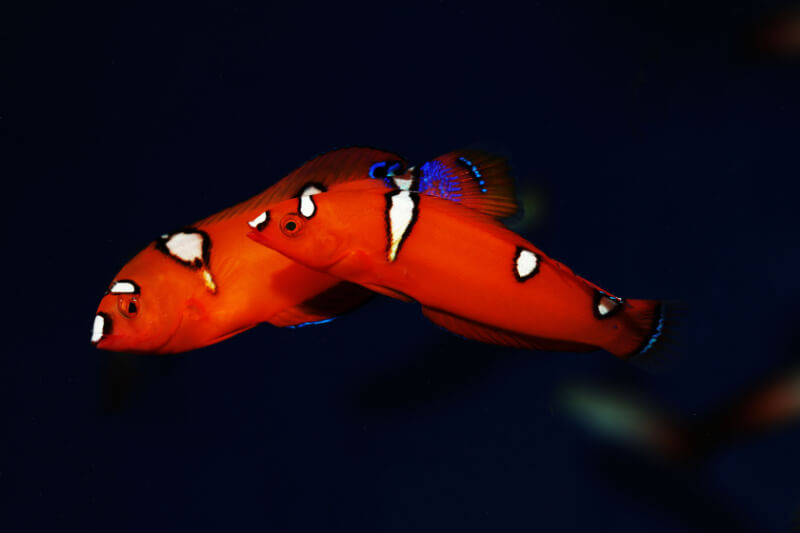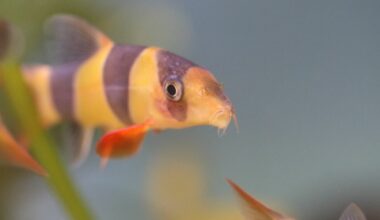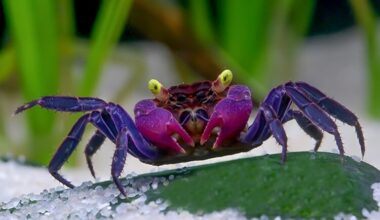Welcome fellow saltwater aquarists to our comprehensive care guide for the captivating Red Coris Wrasse! This species boasts an astonishing coloration transformation as it matures, showcasing a stunning blend of fiery reds, yellows, and purples. It’s truly a sight to behold!
This fish is quite exciting and we are happy to share the best of the best in regards so you can take great care of your Red Coris Wrasse.
So without further ado, let’s dive in together and embark on a journey of discovery and admiration for this remarkable fish!
Table of Contents
Species Summary
Red Coris Wrasses, also called Yellowtail Coris Wrasses, Clown Wrasses or Coris gaimard (scientific name), are an exciting saltwater species known for their stunning coloring. Out in the wild, they’re typically reef dwellers that live in warm places like the Indo-Pacific, Fiji, the Red Sea and around the Hawaiian Islands. They’re active carnivores that will hunt for mollusks and small invertebrates hidden in the sand.
Author Note: Wrasses are great additions to most fish-only aquariums. They can be territorial with others from their species but are typically peaceful.
They have moderate care needs and require optimal water quality to stay healthy. Along with adding more color to your tank, these quirky fish can also help you root out any pesky bristle worms.
Appearance
As juveniles, Yellowtail Coris Wrasses start as small reddish-orange fish that have black-lined white spots along their backs. Once they begin to age, these red scales develop stripes of green and orange. The fins will turn to blue and red with the tail taking on a prominent yellow color. The white and black spots will fade away completely.
The male wrasses are often slightly larger and brighter than the females. The male adults tend to take on a dark gray color and will have a green bar behind the gills. Females, on the other hand, lean more toward blue with a red fringe. Males of this species may subtly change their colors or designs to impress potential mates.
A Red Coris Wrasse has a long, narrow body that enables them to quickly and efficiently hunt down their favorite prey. They’re able to easily squirm into caverns and caves and latch onto shells with their two “tusks” located at the front of the jaw. These fascinating teeth allow them to nab crustaceans out of hiding.

Lifespan
Pinpointing the exact lifespan of these unique fish can be hard out in the wild as it’s easy to confuse the juveniles for other species. With proper management and an ideal tank environment, your Red Coris Wrasse could have a lifespan of 5 years although some sources say up to 8 years!
Average Size
Fortunately for hobbyists, Red Coris Wrasses are one of the smaller fish in the Labridae family with an average size from 6in to more than 12in long. On the other side of the size spectrum, humphead wrasses can reach more than six feet across.
Red Coris Wrasse Care
Yellowtail Coris Wrasses are gorgeous fish that provide a vibrant display in any aquarium. However, they’re not the easiest species to manage and can be prone to unhealthy stress levels and internal infections. Providing them with the right diet and environment will ensure you don’t lose them prematurely.
Tank Size
Wrasses are active fish that need a lot of room to swim and burrow. For one Red Coris Wrasse, the recommended tank size is between 100 and 125 gallons. If you have a small version of this guy you might be able to get by with 50 gallons. Consider investing in a larger 150-gallon tank if you’re interested in bonding a pair.
Water Parameters
Water temperature: 74°F to 80°F
pH levels: 8.1 to 8.4
Water hardness: 8 to 12 dKH
Specific gravity: 1.020 to 1.025
Tank Setup
Your large wrasse aquarium will need between two to four inches of soft, sandy substrate along the bottom. These fish like to bury themselves when they sleep and for protection against predators. Rough substrates like crushed coral or gravel may damage your Red Coris Wrasse’s delicate scales and fins. They need a safe substrate where they can completely submerge themselves.
Author Note: Don’t forget to add caves, crevices, live rocks and other shelter structures. Yellowtail Coris Wrasses constantly move and shift rocks in search of food. They need plenty of digging enrichment to keep them happy and healthy. While this hunting behavior is a great way to find hitchhikers on your live rock, it could result in a disastrous avalanche.
The best way to keep your aquarium safe is to secure any heavy rocks that may fall and crush unsuspecting fish below. Leave plenty of loose stones and objects along the bottom that they can easily flip. These fish also thrive in bright environments with regular water changes and adequate filtration. You’ll want to ensure your tank lid is always tight to prevent any hazardous jumps.
Are Red Coris Wrasses Reef-Safe?
Red Coris Wrasses aren’t entirely reef-safe, but you can add them to your reef tank with caution. Generally, they won’t target your coral polyps. However, they will attempt to consume sessile invertebrates and others like crabs, snails, feather dusters and shrimps.
The biggest danger to consider with Red Coris Wrasses is their rock-flipping behavior. While they won’t directly go after your corals, they may inadvertently damage them when moving nearby rocks and structures. These fish won’t recognize the difference between a polyp and a rock and will turn over anything they can.
Common Possible Diseases & Prevention
Yellowtail Coris Wrasses are hardy fish, but they can develop certain infections and diseases due to stress or a poor environment. For example, interacting with a harsh substrate can lead to internal bacterial infections in the bladder. They can also suffer from fin rot, marine ich and various viral infections. Persistent problems like marine ich require immediate quarantining before it spreads to others in the tank.
A sick wrasse can lose color in its scales, swim erratically, lose weight or grow odd spots or growths. Many health issues start because of overpopulation or poor water quality. You should check the tank’s filter, temperature and specific gravity every day. Be sure to test the water quality weekly and replace about 10% to 25% of the tank’s volume every two to four weeks.
Food & Diet
Your Red Coris Wrasses’ diet can include a mix of brine, ghost or glass shrimp and black worms. You’re welcome to use a mix of frozen, freeze-dried and live foods. For additional nutrition, regularly add vitamin-rich pellets and flakes to their diet.
They should be fed one to two times per day. Allow them to consume as much as possible within about two minutes. You should fully thaw any frozen food before adding it to the tank. Some younger wrasses may need more frequent feedings to offset their initial tank discomfort.
Behavior & Temperament
Yellowtail Coris Wrasses are most active during the day. After they emerge from their sandy bed, they’ll begin searching and exploring the tank. You should expect plenty of burrowing as well as scavenging. If you notice your wrasse is hiding away too frequently, it may be stressed or sick.
Author Note: It’s best to get your juvenile wrasses when they’re already a few inches long. This species doesn’t transport well and can refuse to eat due to excessive stress.
Wrasses are most peaceful when they’re younger, but when they reach adulthood, they’ll become more destructive and territorial.

Red Coris Wrasse Tank Mates
By nature, these wrasses are shy and nervous. They get along well with other peaceful species. A wrasse that refuses to come out of the sand is often a sign that the other tank mates are aggressive. While it may seem like their tusks are useful defensively, they’re used exclusively for digging up food.
The Red Coris Wrasse traditionally lives a solitary lifestyle unless it is in a mated pair. While they can school as juveniles, they’re prone to aggression as adults. It’s never a good idea to put two males in the same tank as they’re likely to clash. Consider adding a wrasse to your aquarium last to lessen their natural territorial instinct.
A few great tank mates for Red Coris Wrasses include:
- Blennies (try the Lawnmower Blenny or the Bicolor Blenny)
- Boxfish
- Clownfish
- Angelfish like the Emperor Angelfish
- Hawkfish
- Rabbitfish
- Butterflyfish (the Copperband Butterflyfish could be one of them)
- Damsels
Breeding
While it’s easy to tell the female and male wrasses apart, getting them to breed in captivity can be near impossible. Always be cautious when introducing two wrasses to the same tank. If you’re lucky, you may see your male and female develop into a mated pair.
During their spawning season, the males will build a nest to attract the female’s attention. The female will then lay eggs in the nest for the male to fertilize. He’ll keep constant guard until they hatch and even afterward until they’re able to survive alone.
Author Note: Even if you provide the right substrate and limit predators in the tank, there’s still a very low chance you’ll successfully breed your Red Coris Wrasses.
Conclusion
We hope this care guide has been a valuable resource for your saltwater aquarium adventure with the captivating Red Coris Wrasse. By now, you’ve learned that their striking coloration transformation and amusing sandbed antics make them a true jewel in any marine tank.
We encourage you to continue exploring and learning about the fascinating world of saltwater aquariums (try these other Saltwater Care Guides). The journey of caring for these remarkable creatures is one filled with wonder and rewards. May your Red Coris Wrasse thrive and bring endless beauty to your underwater sanctuary. And don’t forget to tag us on Facebook when sharing a cool post of your aquarium 😉
Happy fishkeeping!

